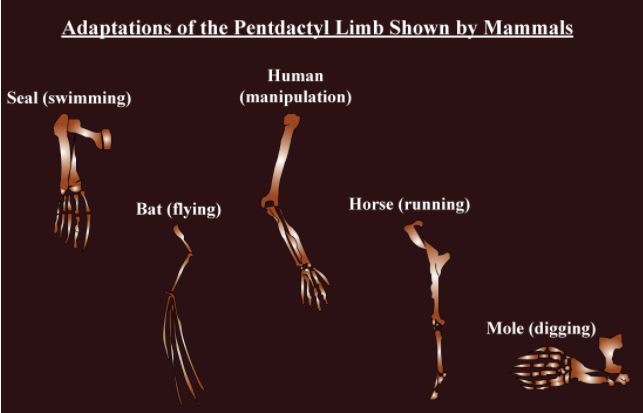
Pentadactyl limb is an example of
A. Analogous Organ
B. Homologous Organ
C. Vestigial Organ
D. All of the above
Answer
574.8k+ views
Hint: They are organs with the same structure but different functions.
Complete answer:
A limb with five digits such as a human hand or foot is called pentadactyl limbs. This pattern of limb bones is an example of homologous structures.
Additional Information:
1. Pentadactyl limbs are found in all classes of tetrapods that are from amphibians to mammals
2. The limb has a single proximal bone (humerus), two distal bones (radius and ulna), a series of carpals (wrist bones), a series of metacarpals (palm bones), and phalanges (digits).
3. Throughout the tetrapods, the basic structure of pentadactyl limbs is the same, indicating that they originated from a common ancestor.
4. During evolution, these limbs got modified, they have become superficially different and unrelated structures to serve different functions in adaptation to different environments and modes of life.
5. This phenomenon generally occurs in the forelimbs of the mammals.
6. It can also help to trace back the fins of certain fossil fishes from which the first amphibians evolved such as Tiktaalik.
So, the correct answer is Homologous Organ.

Note: The best example to explain the pentadactyl limbs is of the horse. The pentadactyl limbs of the horse have evolved and have become something very unique to its purpose and what it does beat is running. Millions of years ago this animal used to be an Eohippus that was very small with a lot more parts to its pentadactyl limb.
Complete answer:
A limb with five digits such as a human hand or foot is called pentadactyl limbs. This pattern of limb bones is an example of homologous structures.
Additional Information:
1. Pentadactyl limbs are found in all classes of tetrapods that are from amphibians to mammals
2. The limb has a single proximal bone (humerus), two distal bones (radius and ulna), a series of carpals (wrist bones), a series of metacarpals (palm bones), and phalanges (digits).
3. Throughout the tetrapods, the basic structure of pentadactyl limbs is the same, indicating that they originated from a common ancestor.
4. During evolution, these limbs got modified, they have become superficially different and unrelated structures to serve different functions in adaptation to different environments and modes of life.
5. This phenomenon generally occurs in the forelimbs of the mammals.
6. It can also help to trace back the fins of certain fossil fishes from which the first amphibians evolved such as Tiktaalik.
So, the correct answer is Homologous Organ.

Note: The best example to explain the pentadactyl limbs is of the horse. The pentadactyl limbs of the horse have evolved and have become something very unique to its purpose and what it does beat is running. Millions of years ago this animal used to be an Eohippus that was very small with a lot more parts to its pentadactyl limb.
Recently Updated Pages
Why are manures considered better than fertilizers class 11 biology CBSE

Find the coordinates of the midpoint of the line segment class 11 maths CBSE

Distinguish between static friction limiting friction class 11 physics CBSE

The Chairman of the constituent Assembly was A Jawaharlal class 11 social science CBSE

The first National Commission on Labour NCL submitted class 11 social science CBSE

Number of all subshell of n + l 7 is A 4 B 5 C 6 D class 11 chemistry CBSE

Trending doubts
What is meant by exothermic and endothermic reactions class 11 chemistry CBSE

10 examples of friction in our daily life

One Metric ton is equal to kg A 10000 B 1000 C 100 class 11 physics CBSE

1 Quintal is equal to a 110 kg b 10 kg c 100kg d 1000 class 11 physics CBSE

Difference Between Prokaryotic Cells and Eukaryotic Cells

What are Quantum numbers Explain the quantum number class 11 chemistry CBSE




